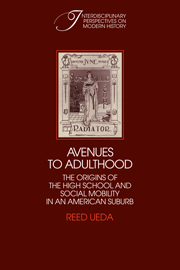Book contents
- Frontmatter
- Contents
- Acknowledgments
- Introduction
- 1 Farm village to commuter suburb
- 2 The evolution of educational leadership
- 3 The free high school
- 4 The rise of Yankee city and the prolongation of schooling
- 5 Popularizing high school: “the college of the people”
- 6 The origins of high school youth culture
- 7 Educational opportunity and social mobility
- 8 The birth of progressive reform and the junior high school
- Conclusion: The high school in the light of history
- Appendix I Courses of study
- Appendix II Sources and methods
- Appendix III Students and households
- Appendix IV Supplementary household data
- Notes
- Index
6 - The origins of high school youth culture
Published online by Cambridge University Press: 04 August 2010
- Frontmatter
- Contents
- Acknowledgments
- Introduction
- 1 Farm village to commuter suburb
- 2 The evolution of educational leadership
- 3 The free high school
- 4 The rise of Yankee city and the prolongation of schooling
- 5 Popularizing high school: “the college of the people”
- 6 The origins of high school youth culture
- 7 Educational opportunity and social mobility
- 8 The birth of progressive reform and the junior high school
- Conclusion: The high school in the light of history
- Appendix I Courses of study
- Appendix II Sources and methods
- Appendix III Students and households
- Appendix IV Supplementary household data
- Notes
- Index
Summary
At the turn of the century, Somerville's high schools served not only as centers of career and college preparation, but also as institutions where youths were socialized by their peer group, rather than by their families or the workplace. By the 1890s, entering classes were sufficiently large and graduation rates rose to ensure a sizable age cohort would pass all the way through high school together. Reaching this demographic threshold set the stage for the growth of an institutionalized peer-group culture.
By 1900, nearly a thousand boys and girls attended the Latin and English High Schools, and, although they were in different educational courses and institutions, they were able to participate jointly in the social-cultural component of secondary schooling called “the extracurriculum.” The extracurriculum consisted of a diverse array of voluntary intellectual, recreational, athletic, and sociable activities. It provided the opportunity for youngsters to express themselves and gain recognition outside of the classroom.
Because extracurricular groups were drawn from both the Latin and English High School they fostered a wider sense of community. Students referred to both schools as a joint institution called “Somerville High School.” For example, the interscholastic athletic teams were recruited from both schools and were called the Somerville High School teams. A writer for the student monthly magazine explained, “The two high schools have always been united by the strongest ties, and it is to this union that Somerville owes her high position in athletics.”
They were subjected to close supervision by faculty sponsors, but extracurricular groups, not their sponsors, were the reference points by which students judged their self-worth.
- Type
- Chapter
- Information
- Avenues to AdulthoodThe Origins of the High School and Social Mobility in an American Suburb, pp. 119 - 152Publisher: Cambridge University PressPrint publication year: 1987



